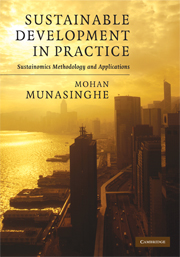Book contents
- Frontmatter
- Contents
- Foreword by James Gustave Speth
- Preface
- Part I Framework and fundamentals
- 1 Overview and summary
- 2 Sustainomics framework
- 3 Economics of the environment
- 4 Ecological and social aspects
- Part II Global and transnational applications
- Part III National and macroeconomic applications
- Part IV Sub-national sectoral and system applications
- Part V Project and local applications
- References
- Index
4 - Ecological and social aspects
Published online by Cambridge University Press: 05 August 2012
- Frontmatter
- Contents
- Foreword by James Gustave Speth
- Preface
- Part I Framework and fundamentals
- 1 Overview and summary
- 2 Sustainomics framework
- 3 Economics of the environment
- 4 Ecological and social aspects
- Part II Global and transnational applications
- Part III National and macroeconomic applications
- Part IV Sub-national sectoral and system applications
- Part V Project and local applications
- References
- Index
Summary
This chapter provides an in-depth discussion of the linkages between the environmental and socioeconomic domains of sustainable development, institutional settings and environmental and social assessments. Some ideas underlying the sustainability of ecological and social systems were discussed earlier in Chapter 2. The basic role of ecosystems in supporting human society and economic activities, and methods of assessing this contribution (including monetary valuation), were explained in Chapter 3. These ideas are extended in Section 4.1, which summarizes the comprehensive conceptual framework based on the Millennium Ecosystem Assessment (MA), including the cyclic interactions between ecological and socioeconomic systems, and the main ecosystem services which sustain human well-being. The MA highlights the precarious situation of many critical ecosystems. The idea of ‘panarchy’ of living systems, and dynamic ecological cycles involving birth, growth, adaptation, decay, death and regeneration, help us understand ecosystem behaviour. Section 4.2 describes the key mediating role played by property rights regimes in determining how societies exploit natural resources. Property rights regimes play an important role in designing and implementing sustainable environmental management measures. Their effectiveness largely depends on the congruency of well specified property rights regimes with ecological and social factors, especially in the case of traditional societies and native peoples who are heavily dependent on ecological resources, as well as the landless poor who subsist in degraded areas. Finally, in Section 4.3, environmental and social assessments are described as important elements of sustainable development assessment, which complement cost–benefit analysis (or economic assessment).
- Type
- Chapter
- Information
- Sustainable Development in PracticeSustainomics Methodology and Applications, pp. 111 - 134Publisher: Cambridge University PressPrint publication year: 2009



